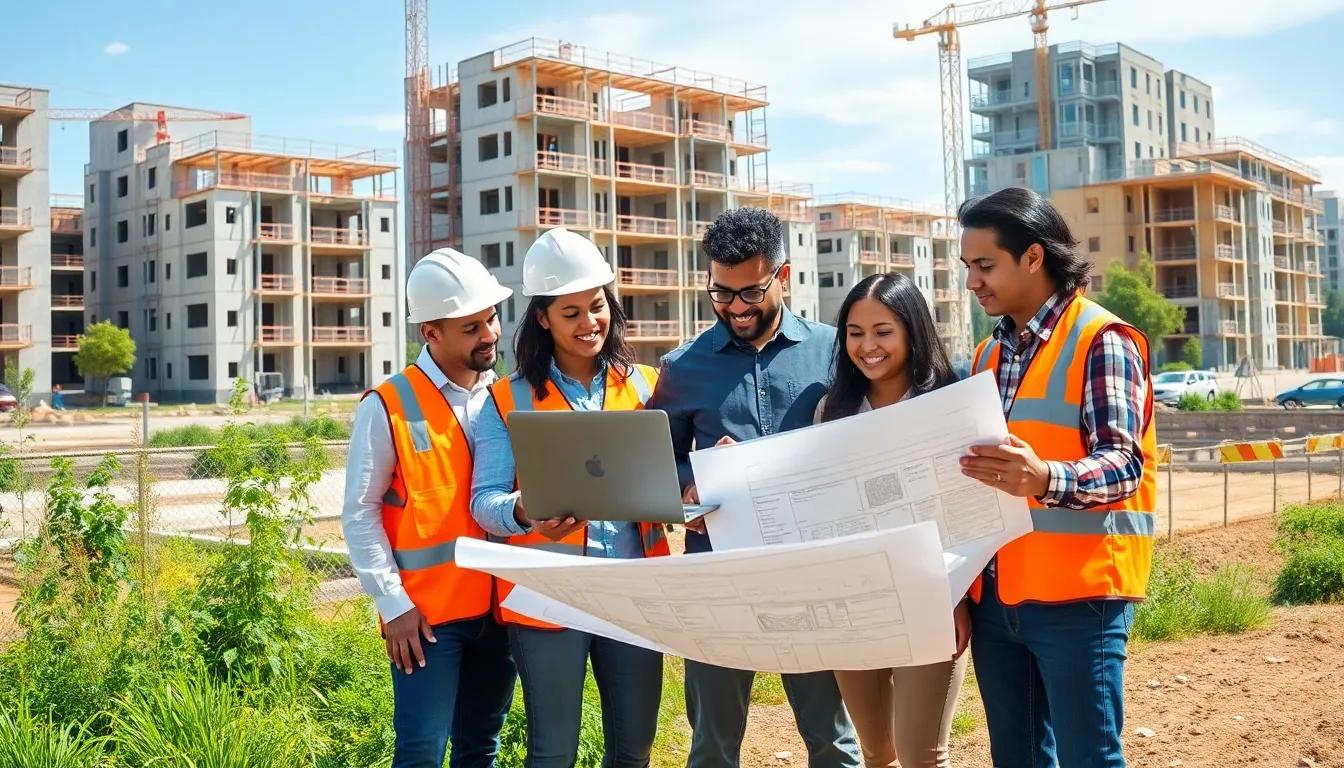Civil design concepts are the unsung heroes of infrastructure, quietly shaping the world around us while we sip our morning coffee and complain about traffic. From the roads we drive on to the bridges we cross, these principles are the backbone of modern society, ensuring safety and functionality. But let’s face it: civil design isn’t exactly the hottest topic at dinner parties.
Table of Contents
ToggleOverview of Civil Design Concepts
Civil design concepts play a pivotal role in shaping the infrastructure essential for daily life. These concepts prioritize safety, efficiency, and sustainability in creating various structures. Key elements include site analysis, which assesses geographic and environmental conditions. Additionally, understanding load-bearing requirements ensures structures can support expected traffic.
Design principles also emphasize accessibility for individuals with disabilities, making public spaces inclusive. Aesthetic considerations contribute to the overall functionality of a design. Landscape integration enhances visual appeal and harmony with the surrounding environment.
The planning phase often involves collaboration among engineers, architects, and urban planners. This teamwork allows for a diverse range of perspectives during the design process. Incorporating advanced technology, like building information modeling (BIM), streamlines project development and reduces errors.
Furthermore, adherence to local regulations and zoning laws is critical. Compliance ensures projects align with community standards and sustainability goals. Environmental impact assessments evaluate potential effects on ecosystems, guiding responsible construction practices.
Finally, continual evaluation and adaptation of civil design concepts support advancements in materials and methods. By embracing innovative techniques, communities can meet ever-evolving needs. These concepts collectively contribute to the functionality and longevity of infrastructure, ultimately enhancing people’s quality of life.
Key Principles of Civil Design

Civil design principles guide the creation of effective infrastructure. These concepts emphasize the balance between multiple factors, ensuring environments serve the public well.
Functionality and Aesthetics
Functionality drives the design of infrastructure. It ensures structures meet practical needs, such as load-bearing capacities and accessibility features. Aesthetic appeal should not be overlooked. Visual harmony enhances user experience and promotes community pride. Integrating natural landscapes into design adds to functionality while beautifying spaces. Placement of elements like trees or benches can create inviting environments. Therefore, engineers and architects collaborate to achieve a balance between function and form, creating seamless transitions in community spaces.
Sustainability and Environmental Impact
Sustainability remains crucial in civil design. It focuses on using materials and practices that minimize environmental harm. Incorporating green technologies can reduce energy consumption in buildings and infrastructure. Environmental impact assessments guide these choices. These assessments identify potential issues before construction begins, reducing risks to ecosystems. Additionally, prioritizing local materials lessens carbon footprints. Every aspect, from water management systems to renewable energy sources, supports sustainable practices. Builders embracing sustainability contribute to healthier communities and lasting infrastructure.
Effective Project Management in Civil Design
Effective project management ensures successful civil design initiatives. This phase encompasses various critical aspects that lead to the realization of construction projects.
Planning and Scheduling Techniques
Prioritizing thorough planning and scheduling techniques enhances project efficiency. Engineers employ methods such as Gantt charts and critical path analysis to visualize timelines. Each task gets assigned a specific timeframe, ensuring timely completion. Collaboration among team members fosters open communication, reducing the risk of delays. Utilizing software tools streamlines these processes by automating updates and monitoring progress. Regular reviews of schedules keep the project aligned with its objectives. Adaptations happen based on emerging challenges, maintaining project momentum throughout the construction phase.
Budgeting and Resource Allocation
Effective budgeting and resource allocation play pivotal roles in civil design projects. Estimating costs accurately prevents overspending and enables strategic resource management. Teams analyze expenses for materials, labor, and equipment to create realistic budgets. Prioritization shifts towards procuring local materials, which can reduce transport costs and support local economies. Tracking expenditures continuously ensures alignment with budget constraints. Adjustments occur promptly to address any financial discrepancies that arise. Proper resource allocation maximizes efficiency, enabling the project to meet deadlines without sacrificing quality.
Innovations in Civil Design Concepts
Innovations in civil design concepts enhance infrastructure through the integration of modern technologies and materials. These advancements lead to safer, more efficient, and sustainable environments.
Smart Technologies and Infrastructure
Smart technologies revolutionize civil design by improving operational efficiency and safety. Tools like sensors and IoT devices provide real-time data for monitoring structural integrity, traffic patterns, and environmental conditions. This data empowers engineers and planners to make informed decisions and adapt designs according to user needs. For instance, smart traffic signals optimize traffic flow, reducing congestion and emissions. Furthermore, predictive maintenance technologies alert teams to potential issues before they escalate, ensuring infrastructure longevity. Thus, the incorporation of these technologies not only streamlines projects but also enhances community usability.
Use of Sustainable Materials
Sustainable materials play a crucial role in innovative civil design. Using recycled aggregates and reclaimed wood decreases environmental impact while supporting local economies. Additionally, permeable pavement systems improve water management, reducing runoff and promoting groundwater recharge. Innovations like transparent solar panels and green roofs further enhance energy efficiency and biodiversity. Material choices influence the overall carbon footprint of projects and align with the shift toward sustainable development goals. Civil engineers prioritize these resources to create structures that fulfill current needs without compromising future generations.
Challenges in Civil Design
Civil design faces numerous challenges that can impact the effectiveness and efficiency of infrastructure projects. Key difficulties often arise from regulatory and compliance issues.
Regulatory and Compliance Issues
Navigating regulatory frameworks presents a significant challenge in civil design. Each project must comply with zoning codes, environmental regulations, and safety standards. Noncompliance can lead to project delays or financial penalties. Consequently, civil engineers must stay updated on local and federal regulations, which frequently change. Understanding and integrating these requirements into designs ensures that projects meet necessary approvals without complications. It’s also crucial to conduct thorough environmental impact assessments, as these evaluations guide responsible construction practices.
Community Engagement and Feedback
Community engagement serves as another challenge in civil design. Gathering feedback from residents enables engineers to understand local needs and expectations. Effective engagement can contribute to project success by building trust and fostering collaboration. However, balancing diverse opinions can be difficult. Some residents may resist changes that affect their neighborhoods. Structured outreach, including public meetings and surveys, helps collect valuable insights while addressing concerns. Actively involving the community can enhance project relevance and ensure long-term acceptance of infrastructure designs.
Civil design concepts play a pivotal role in shaping the infrastructure that supports daily life. By integrating safety, efficiency, and sustainability, these principles ensure that public spaces are not only functional but also visually appealing. Collaboration among professionals and the use of modern technologies are vital for successful project execution.
As communities evolve, the need for innovative solutions becomes increasingly important. Embracing new materials and smart technologies can significantly enhance infrastructure resilience and user experience. Ongoing assessment and adaptation of design practices will ultimately lead to sustainable development that enriches community life. Prioritizing these elements will help create environments that are safe, inclusive, and harmonious.









